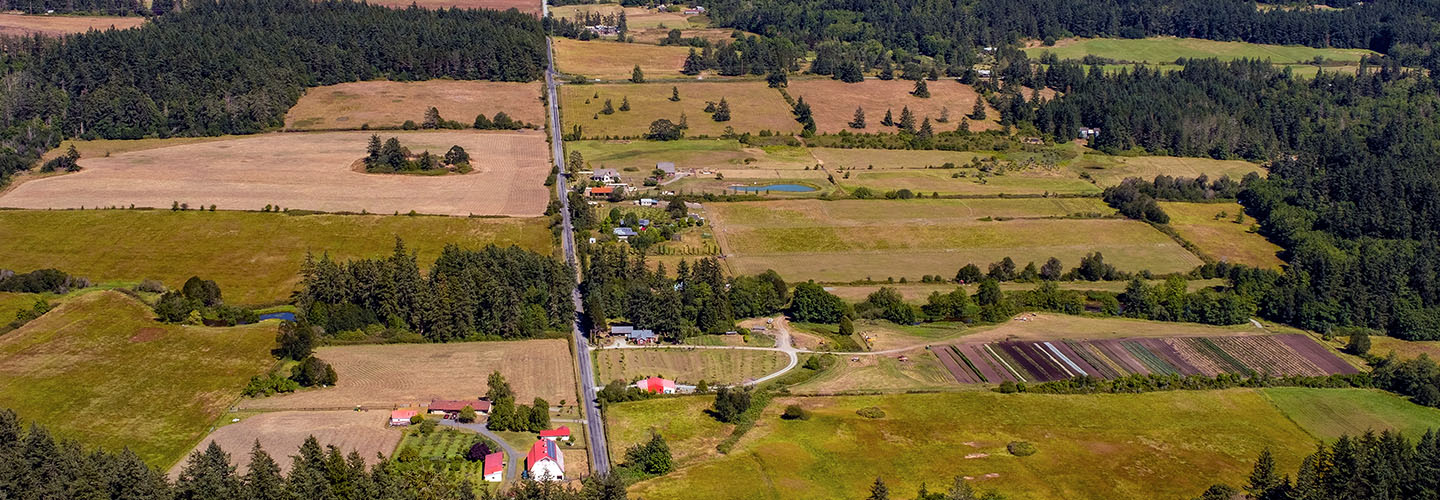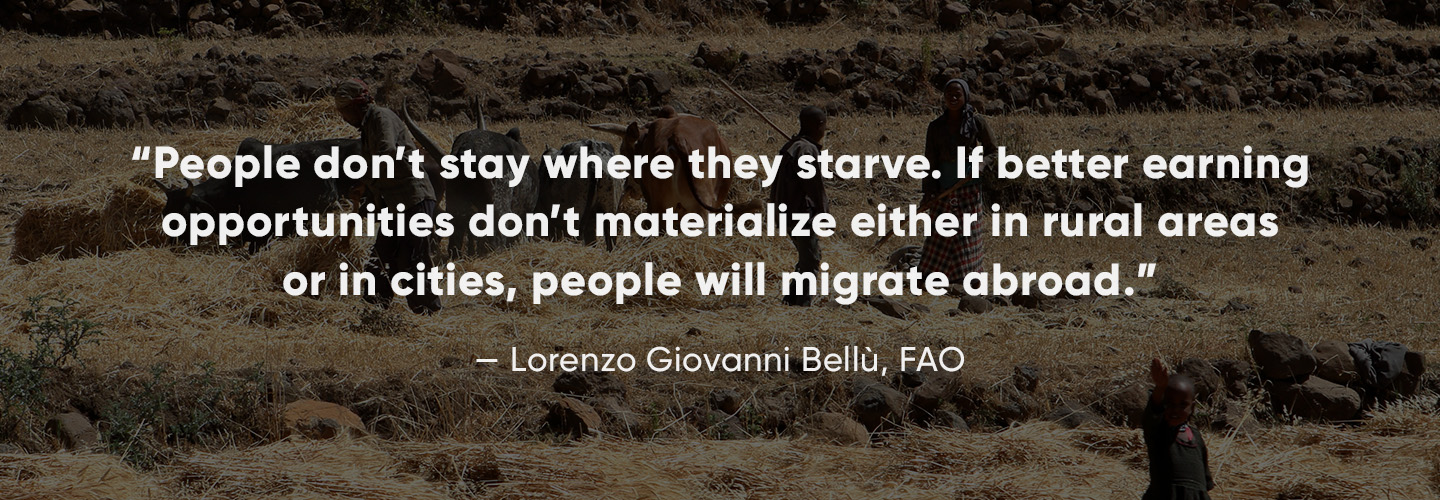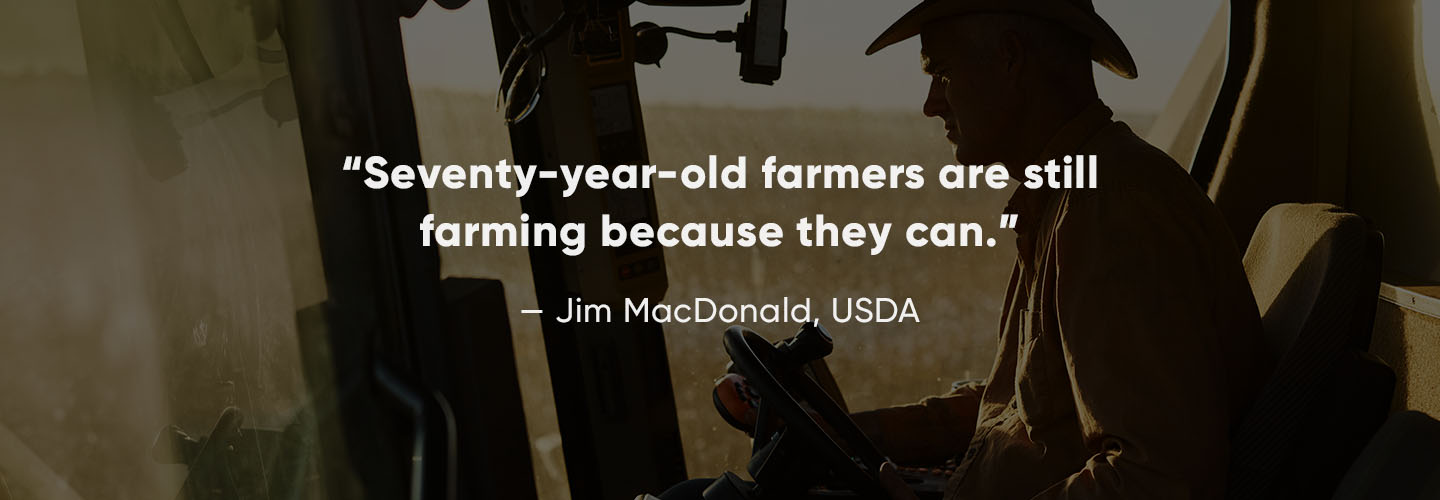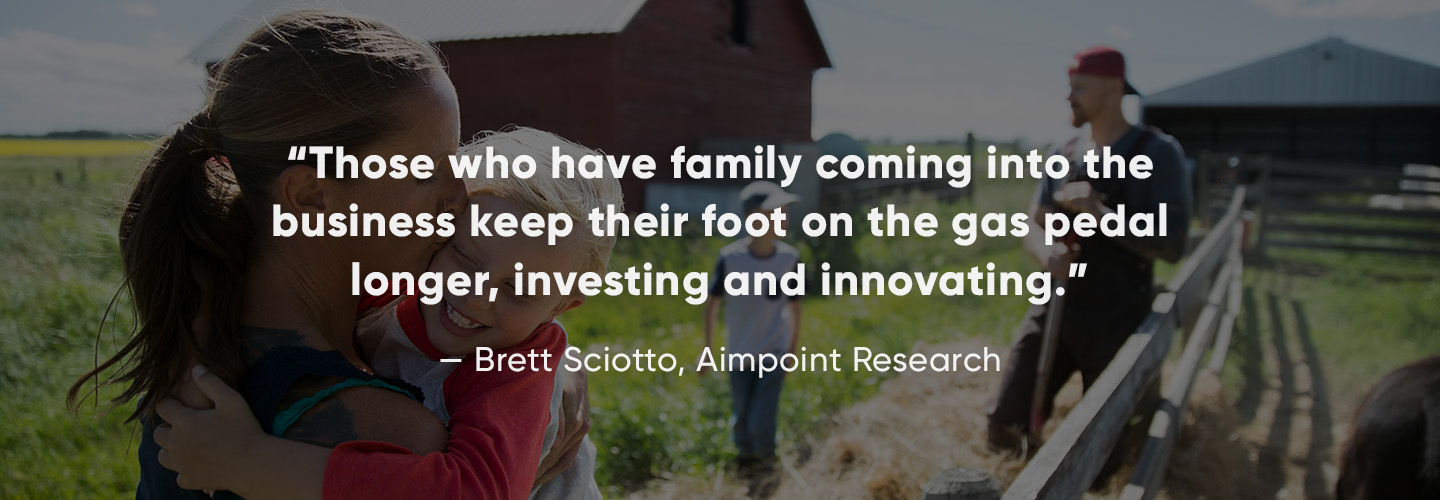Are Shrinking Farms and Older Farmers Good for Food Security?

Can world food production keep pace with population growth? Three trends in agricultural demographics raise concerns:
Why? Because smaller farms are likely to yield less, and older farmers are likely to produce less, according to some. A pipeline drained of next-generation farmers implies a future without enough agricultural producers. Coupled with climate change, regional conflict, and inefficiencies in the food system, these demographic shifts could spell disaster for millions. Indeed, the UN’s Food and Agriculture Organization (FAO) forecasts that fully 1.2 billion people (more than 11 percent of the world’s population) will go hungry in 2050 if current income disparities widen, further threatening food security and stratifying societies into haves and have-nots.
But while that dire outcome is certainly possible, it’s not the only way to interpret the evidence. For many economists, the changing nature of farms and farmers is as likely to be a source of resilience for, as opposed to pressure on, the global food supply. Here’s how they see key trends affecting food security.
Shrinking farms
Small farms account for most of the world’s 570 million farms: fully 84 percent are smaller than two hectares, and 72 percent are smaller than one hectare, according to the FAO. The vast majority are thought to be subsistence operations, producing food but not contributing to agricultural production. Worldwide, their land accounts for only 12 percent of farmland, but that figure disguises their preponderance in East Asia and the Pacific (excluding China), South Asia, and sub-Saharan Africa, where smallholders manage upwards of 40 percent of farmland.
The success of these smallholders is crucial to the survival of literally billions of people. And the shrinking size of their plots—a trend that’s persisted throughout Asia, Africa, the Middle East, and parts of Latin America since 1960—would seem to jeopardize their success. In China, home to 200 million smallholders, average plot size has shrunk to just over half a hectare, or about the size of a soccer field, although efforts to consolidate farms there have begun in earnest.

In China, home to 200 million smallholders, average plot size has shrunk to just over half a hectare, or about the size of a soccer field.
Still, the data show that in much of the world, smallholders are doing better than subsisting and are no longer in danger of starving. Stunting, wasting, and micronutrient deficiencies still affect unacceptable numbers of children, but daily per-person caloric intake, a standard litmus test of food security, has steadily risen overall, from 2,753 in 2005 to 2,904 in 2016, according to the FAO. Currently, 21 percent of people in the world’s 76 low- and lower-middle-income countries face food insecurity, but that is expected to drop to just 10 percent by 2028—an astounding 50 percent reduction.
How can this be? Because rising GDP from productivity off the farm means that many smallholders no longer need to depend on the farm for sustenance.
This is particularly evident in South and Southeast Asia, according to Steve Wiggins, a senior economist at the Overseas Development Institute (ODI) who has studied rural populations there since 1972. Urbanization, industrialization, and manufacturing jobs have given many smallholders and their families enough surplus capital, he says, to buy not just more of the food they need, but other products and services as well. With more money going around, rural economies have grown, adding jobs not only for people who supply farmers, or who transport, store, or process their crops, but also for masons, carpenters, pipe-fitters . . . even wedding caterers.
And when rural economies are no longer dependent solely on agriculture, he points out, “it doesn’t matter if the farm is only half a hectare: with a bit of capital, education, and entrepreneurship, smallholders can make a good living.” Wiggins believes that, for much of Asia, the end of mass poverty is in sight. “It’s the Great Asian Miracle,” he says.
Glimmers of hope
That miracle hasn’t yet extended to Africa, however, where food insecurity is worsening. In fact, the past several years have been challenging for food security worldwide. Of the 720 to 811 million undernourished people in the world in 2020, 281.6 million lived in Africa. That’s particularly worrisome, says Lorenzo Giovanni Bellù, senior economist and head of the Global Perspectives Studies team at the FAO, because most of the world’s population growth is expected to take place in the region. The population of Niger is projected to grow four-fold by 2050; Uganda’s population is expected to almost triple.
And unless countries in the region begin to mechanize their agriculture and develop manufacturing sectors or other activities that can create jobs and diversify rural incomes, the rural economies of sub-Saharan Africa will collapse, spurring massive waves of migration. “People don’t stay where they starve,” Bellù says. “If better earning opportunities don’t materialize either in rural areas or in cities, people will migrate abroad.” The waves of both voluntary and “distress” migration that have already reached Europe “may be the tip of the iceberg,” he adds, unless agriculture investments and social protection schemes can be implemented.

Ishmael Sunga, an economist and the CEO of the Southern African Confederation of Agricultural Unions (SACAU), agrees with Bellù. “The system at the moment is unsustainable,” he says. Not only are individual holdings ever smaller, fragmented, and geographically dispersed, but budgetary constraints coupled with ongoing conflict in many of these countries have thwarted investment in the basic infrastructure—water, schools, health clinics, roads, rail, electricity, and communication networks—so crucial to facilitating commerce between rural and urban populations. “Even if you could grow your yields,” he continues, “why would you, when structural issues would prevent you from getting your produce to market?” As Sunga sees it, without connectivity—social, economic, geographical—African smallholders are isolated and “food for vultures.”
Yet Wiggins, for one, remains hopeful, having overlooked the seeds of economic productivity in Bangladesh after the famine of 1974 and underestimated the impact of the private sector on economic growth in Thailand in the mid-1980s. He cites studies conducted in contemporary rural Tanzania that reveal slow but steady growth in village prosperity since the early 1990s as smallholders contract with outside traders, invest in their land, boost their productivity, and spread their earnings around. Researchers describe the economic growth that one new road catalyzed in a remote corner of Tanzania, where traders contracted with villagers to grow sesame seeds for export to India; now the village has new roofs. In a coffee-growing area, they recount how smallholders are grubbing out coffee bushes to grow carrots, onions, and other produce for urban markets because they pay better than coffee export markets.
“Once there’s access to the wider economy, the miracle begins,” Wiggins concludes. “What happened in Thailand isn’t yet true in Tanzania, but I think in 20 years’ time we’ll be pinching ourselves.”
Labor-saving devices
Meanwhile, back in the world’s breadbasket countries, farmers are old—nearly 60, on average—and getting older. But agro-economists aren’t worried, because the nature of large-scale farming has matured along with the farmer. It’s no longer backbreaking work, thanks to remarkable advances in equipment for tilling, planting, transplanting, and harvesting. Indeed, the mechanization and automation of farming—particularly auto-guidance systems, which steer agricultural vehicles by satellite—explain why the average age of the farmer continues to rise along with yields. “Seventy-year-old farmers are still farming because they can,” says Jim MacDonald, chief of the Structure, Technology, and Productivity branch at USDA’s Economic Research Service. “They’re sometimes the first adopters of new technologies, because they can see the benefits in terms of reduced physical and mental stress.”

Perhaps because age connotes experience, some argue that maintaining the stupendous yields of the world’s mega-farms—anywhere from 1,000 to 10,000 hectares—in the U.S., Latin America, Eastern Europe, and Oceania will depend on retaining the industry’s most seasoned players. Commercial farming at scale is a complex operation that requires not just agricultural expertise, but knowledge of global markets; not just people-management skills, but inventory-management skills. Principal operators must be able to negotiate with vendors, hire and manage service providers, comply with regulators, and be responsive to shareholders and landlords. As Dan Sumner, director of the UC Agricultural Issues Center at UC Davis puts it, “Commercial farming has never been a business for beginners.”
Research shows that in the coming decades, the business of farming will become even more complex, and succeeding at it will demand ever more educated and agile principals at the helm. “They’ll be more like corporate CEOs than farmers,” says Brett Sciotto, CEO of Aimpoint Research, which over the last year has analyzed industry trends, in-depth surveys back to 2002, psychographic data, and war-gaming exercises to determine who will lead the agricultural industry in 2040. According to the study, 69 percent of tomorrow’s farmers will have a bachelor’s degree or higher, and not always in agriculture but in business. Like today’s CEOs, they will need to heed the demands made by supply-chain partners and consumers—an accommodation that today’s fiercely independent farmers resist. “Being able to adapt,” Sciotto says, “may be the differentiator as to who succeeds and who doesn’t.”
Where age does threaten productivity is in the labor force, economists agree. Farmhands’ average age is also rising, as very few young people are going into farm work. Aging workers struggle with “stoop labor”—bending over to pick berries or other ground-hugging produce that must be harvested by hand.
Yet here too, innovation has the potential to make age a nonissue. Sumner points to a plethora of solutions, from high-tech stuff like robot pickers; to low-tech solutions such as having a deeper trench and a higher mound for strawberries, or growing crops in baskets or on tables so that workers can remain upright; to biotech solutions, such as modifying olive-tree genes so that the tree maintains yields but grows only to shrub height.
“We’re going to continue to see some gee-whiz tech, not just from engineers but also from plant scientists, economists, and agronomists, all of whom are working together on this,” he says. “It’s a combination that may solve not just for aging labor, but for the ongoing labor shortage.”
Urbanization and feminization
If agricultural labor is in short supply worldwide, it’s in large part because of urbanization. More than 50 percent of the world’s population now lives in cities, and by 2050, fully 70 percent of us will have moved to one, mostly in search of better prospects for jobs, income, and marriage. In the developing world, men’s migration from rural villages to urban areas has another effect: it leaves women in charge of the farm, the so-called “feminization” of agriculture. (See "Women in Agriculture.”)

More than 50 percent of the world’s population now lives in cities, and by 2050, fully 70 percent of us will have moved to one.
As noted, higher GDP is a tide that eventually lifts all boats. Remittances from high-earning family members can help propel smallholders out of subsistence farming, and modest prosperity, coupled with women-friendly family planning services, has been shown to bring down fertility rates in rural populations. Studies show that as incomes rise, heads of households are more likely to have fewer children and to educate the ones they have to be able to compete for high-paying urban jobs. Urbanization thus ultimately promotes food security by reducing population growth, says Wiggins, who’s studied the phenomenon throughout the developing world, including in sub-Saharan Africa. He notes that more schooling allows young women to earn a living and gain independence, he says—and escape the wood-gathering, water-toting, subsistence living that results in big families and food insecurity.
Even for women who remain in agriculture, industrialization due to urbanization has transformed their earning potential. In Zanzibar, an island off Tanzania where seaweed is the top export, women still do 80 percent of the farming. But thanks to a government training initiative, they also oversee the production and sale of added-value products like soap, lotions, and food, and even conduct tours of their processing facilities for visitors to the island. As a result, the women’s income has skyrocketed, enabling them to afford to build their own homes, send their children to school, gain business knowledge, and learn English. “It just goes to show you the importance of moving farmers—both women and men—up the value chain,” says John Ruane, a senior consultant in agricultural innovation with the Research and Extension Unit of FAO.
Most importantly, however, by squeezing the rural labor supply, urbanization drives up rural wages—which in turn builds rural economies. Higher wages help keep rural youth from migrating to cities and factories; in some parts of rural China, says ODI’s Wiggins, there is even reverse migration back to villages. Higher labor costs pressure operators to rent or lease machines to close the labor gap; farm equipment boosts yields, potentially boosting profits. Commercially viable farms in turn attract a host of service providers, from tractor mechanics and irrigation-pump technicians to quality seed and fertilizer purveyors.
In this way, urbanization has pulled rural economies out of poverty. “Twenty years ago in Bangladesh, you could stand under a tree, wave a few dollars, and have dozens of villagers begging you to choose them for your farm work,” Wiggins says. “Now, you can’t find enough workers. The days of rising rural populations and lots of people prepared to work for next to nothing are over.”
Who’s next?
Who will take over the family farm? Not necessarily a family member. At least in the U.S., where upwards of 40 percent of farmland is leased, and 87 percent of landlords are not farmers, only about half of all farmland passes from one relative to another, either through purchase, gift, or inheritance.
Nonfamily succession might be cause for concern, if only because research shows that principal operators who have sons and daughters poised to take over the farm are highly motivated to invest in their land, invest in their business, and do everything they can to secure a future for coming generations. “There’s a strong correlation—and we were surprised at how strong—between farmers who have family members involved and those who do not,” says Aimpoint’s Sciotto. “Those who have family coming into the business keep their foot on the gas pedal longer, investing and innovating. Whereas those who do not, slow down the pace of adaptation, which leads to the operation becoming less competitive. Having a family member in the chute is a tremendous motivator.”

UC Davis’s Sumner isn’t concerned about either the rising proportion of nonfarmer landlords or the increase in land transfers and rentals to nonfamily members. “Everywhere I look, I see farmers doing a better job than they were 40 or 50 years ago in terms of sustaining the land and those who work on it, whoever they may be,” he says. “If you’re known as someone who doesn’t take care of the land, you’re out of business.”
The shift from family to nonfamily ownership and land transfer has in turn changed the demographics of U.S. farmers: increasingly, they are Hispanic. “While Hispanics make up a significant share of hired labor and contract workers, they are also foremen and managers,” says the USDA’s MacDonald. “I anticipate we’ll see more of them and their children showing up as operators and senior managers in our statistics.”
And despite the statistics showing that 33 percent of beginner farmers are age 55 and over, MacDonald sees no diminution in the pipeline of young talent drawn to farming. Many are family members who simply aren’t visible because they aren’t listed as principal operators but nonetheless are learning the craft. Many are coming out of agriculture school and going into businesses that serve farmers—precision-agriculture consultancies, software and data analysis providers, drone operators, and autonomous equipment manufacturers or service technicians—and may ultimately use that income to acquire land they will farm themselves. “They see that running a big commercial farm is risky, but that on average, you can make a lot of money,” he says. “That pulls in a lot of young people, not necessarily as operators, but as service providers and consultants. That’s because there’s a big question now about who’s going to make the operating decisions, when so much of the operation depends on high-tech equipment and specialized knowledge.”
In short, says MacDonald, “People still enter farming because the incomes earned by commercial farmers match or exceed what people can earn operating other businesses.”
Still, agriculture increasingly depends on innovation to solve for the challenges posed by climate change, population growth, and dwindling resources. MacDonald believes the industry could benefit from a greater diversity of people going into it. “New people, with new thinking, are what will make farming more vibrant, more viable,” he says. To that end, he’d like to see more women and people of color applying to agricultural-degree and land-grant programs, as these are the pathways to getting into large-scale operations and the consultancies that serve them. He adds, “Our future food security could well depend on them.”